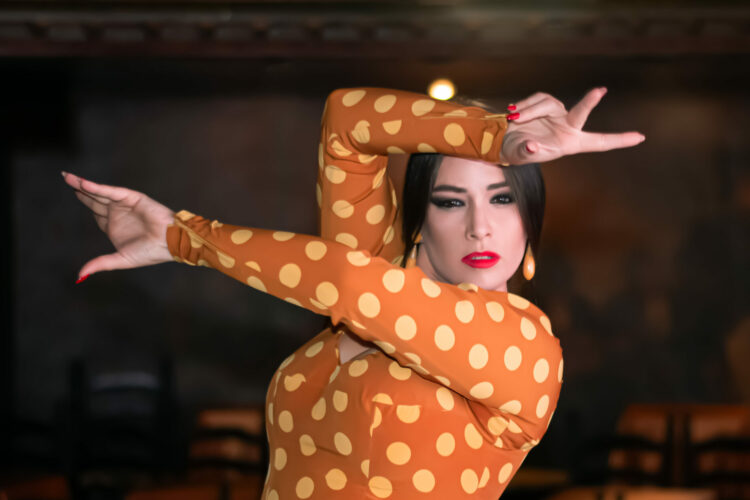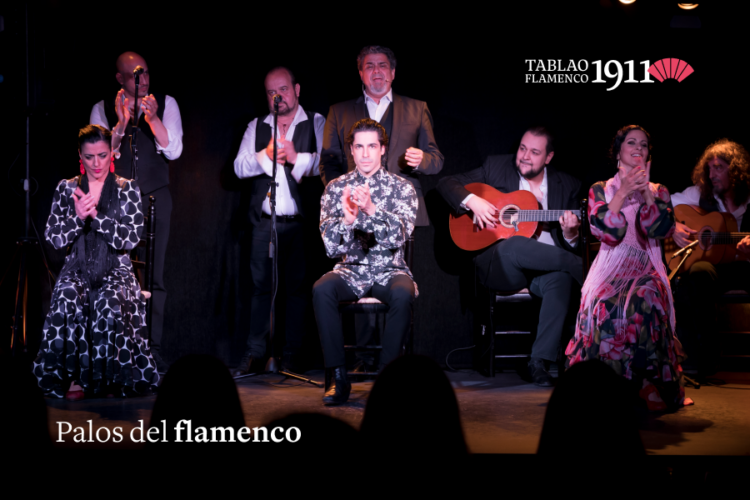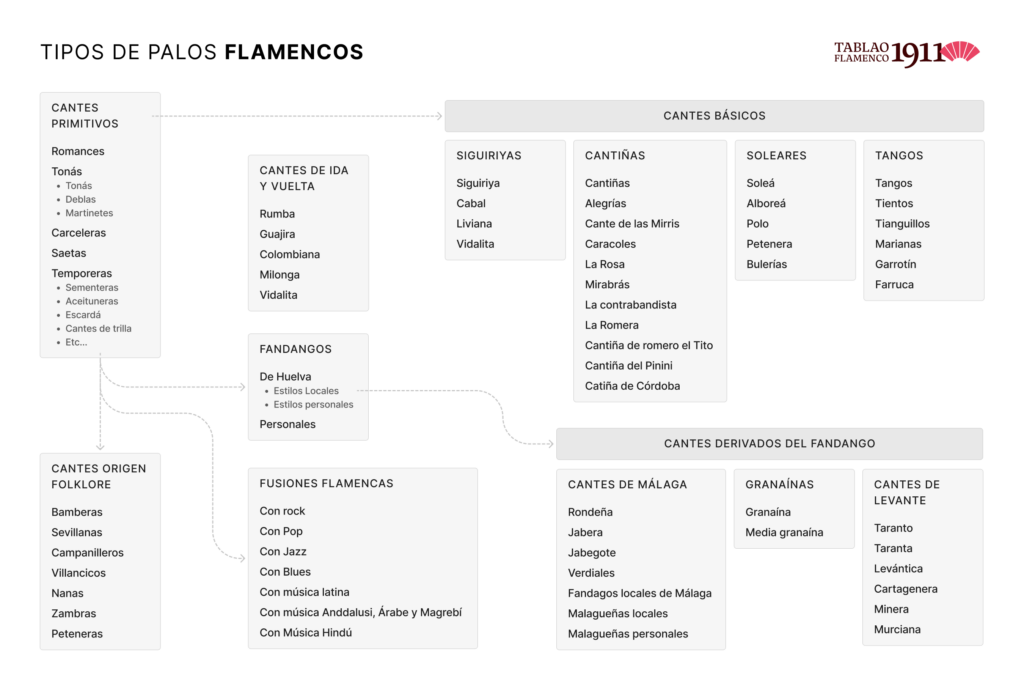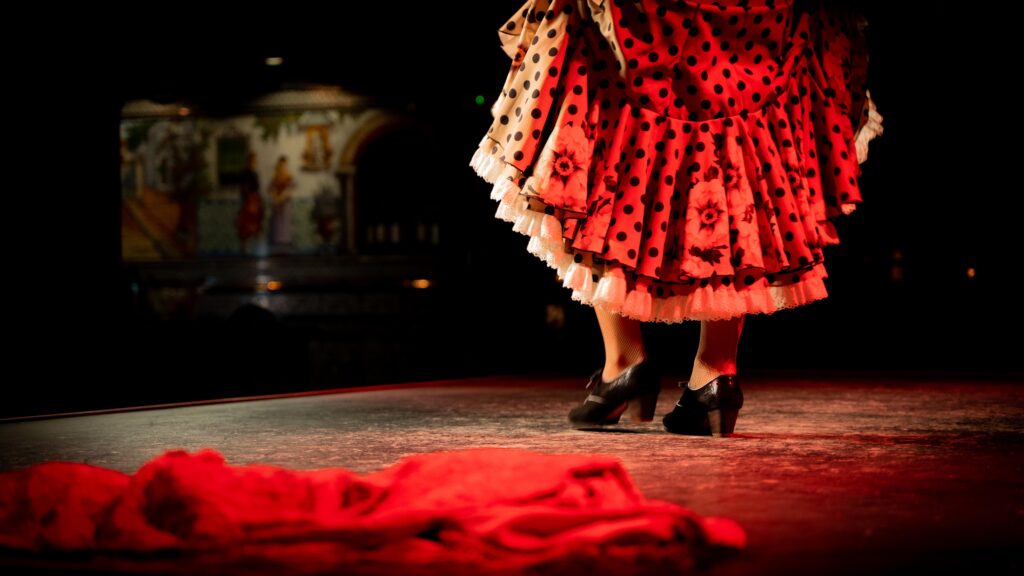
Paula Rodríguez returns to 1911
Paula Rodríguez, pure passion, strength, and elegance!

Flamenco: Passion, rhythm, soul. These words probably sound familiar. But flamenco is much more than a single frozen image; it’s a vibrant universe full of nuances. The key to its richness and variety? The flamenco palos.
If you’re curious to know what makes an Alegría different from a Soleá, or why some songs move you to the core while others make you want to dance, keep reading! We’re going to break down what the flamenco palos are. Get ready to take the first step toward truly understanding flamenco.
Think of flamenco as a vast, living tree, with deep roots in Andalusia.
The flamenco palos would be its main branches, each with its own unique leaves and flowers. Each “palo” is essentially a different style, a distinct musical form within the grand universe of flamenco.
Each one has its unmistakable character, its particular rhythm (the famous compás), its typical melodies, and even its own historical and geographical roots.
The deep lament of a Seguiriya doesn’t vibrate the same as the festive spark of a Bulerías.
Each palo has its own aire—that unique atmosphere, that feeling which artists masterfully convey through their voice, body, or guitar strings.
Grasping this diversity is the first step in understanding the flamenco structure.
Here lies one of the great keys (and sometimes a small challenge!) to understanding the flamenco palos: the flamenco compás.
The most famous is a 12-beat cycle—not counted just any way, but with accents falling in places you might not expect, and that’s exactly what gives it that special, thrilling flavor!
Don’t worry about the theory just yet (we’ll dedicate an entire post to the compás!), but hold on to this idea: this 12-beat rhythm is at the heart of major palos like the Soleá, Alegrías, and Bulerías.
Other palos, like the Fandangos or Tangos, use simpler rhythms (3 or 4 beats). You’ve already got a key clue to start telling them apart!

The flamenco tree has many branches! It’s said that there are over 50 documented palos, a true cultural treasure.
To avoid getting lost in this wonderful jungle of sound and emotion, we can group them into “families” based on their feel, origin, or rhythm.
There are more than 50 catalogued flamenco palos—here are some of the most important types:
Considered the “mother of singing”, the Soleá is the pure essence of deep flamenco (jondo). Its 12-beat compás is slow and solemn. Its lyrics speak of sorrow, love, and deep emotion. Other styles like the rhythmic Soleá por Bulerías come from it.
If you’re looking for drama and tragedy turned into song, this is the place. The Seguiriya and its relatives (Liviana, Serrana) express the deepest pain, with a complex and fascinating compás that draws you in.
Let’s head to the Bay! These are full of light and grace within a 12-beat compás. The Alegrías are the queens of this family, with elegant dance and joyful singing, but you’ll also find Caracoles, Mirabrás, and Romeras.
Here we switch to a more straightforward 4-beat compás. Flamenco Tangos (very different from the Argentine version!) invite movement with their sensual and catchy feel. This group includes slower Tientos and festive palos like the Farruca or Garrotín.
A huge and very old family, usually with a 3-beat compás. There are countless variations: the famous Fandangos de Huelva (with styles unique to each village), personal fandangos (created by iconic singers), and palos like the Malagueña, Granaína, or Taranta, born in eastern Spain and mining regions.
These are palos with a traveling history. They went to the Americas, mixed with local rhythms, and returned transformed. Guajira, Colombiana, Milonga, and Rumba flamenca all have a unique flavor.
We can’t forget Bulerías (a party made into 12-beat compás, essential at the end of any flamenco gathering), primitive cantes without guitar (Martinetes, Tonás), the enigmatic Peteneras, or the popular Sevillanas… a world waiting to be discovered!

Fancy playing flamenco detective next time you watch or listen to a show? While it takes time to train your ear, you can start by noticing this:
The Emotion (El Pellizco): What main feeling hits you? Pure joy, melancholy, solemnity, rage, or carefree celebration?
The Rhythm: Does it feel fast and makes you want to move, or is it slower, heavier, inviting introspection?
The Voice (Cante): Does it sound highly ornamented, broken, almost like a cry? Or is it more melodic, straightforward, with a clear chorus?
The Body (Dance): Do you see explosive moves and quick turns? Or maybe more restrained arm movements, strong but sober footwork, and inward expression?
The best school, no doubt, is to listen a lot, ask questions, and above all, feel the flamenco live.
Reading about the flamenco palos is great, but feeling them live is a completely different story! At our historic Tablao Flamenco 1911, right in the heart of Madrid, we offer you an authentic journey through this incredible diversity of styles.
Night after night, our artists (true masters of their craft!) take you from the depth of a spine-tingling Soleá, to the contagious spark of some joyful Alegrías, through the rhythmic whirlwind of the Bulerías, or the solemn power of the Seguiriya. The intimate atmosphere of our tablao lets you capture every nuance of the singing, every vibration of the guitar, every precise stomp of the dancer. This is real flamenco—raw, close, and unfiltered.
Want to feel flamenco in its purest form?